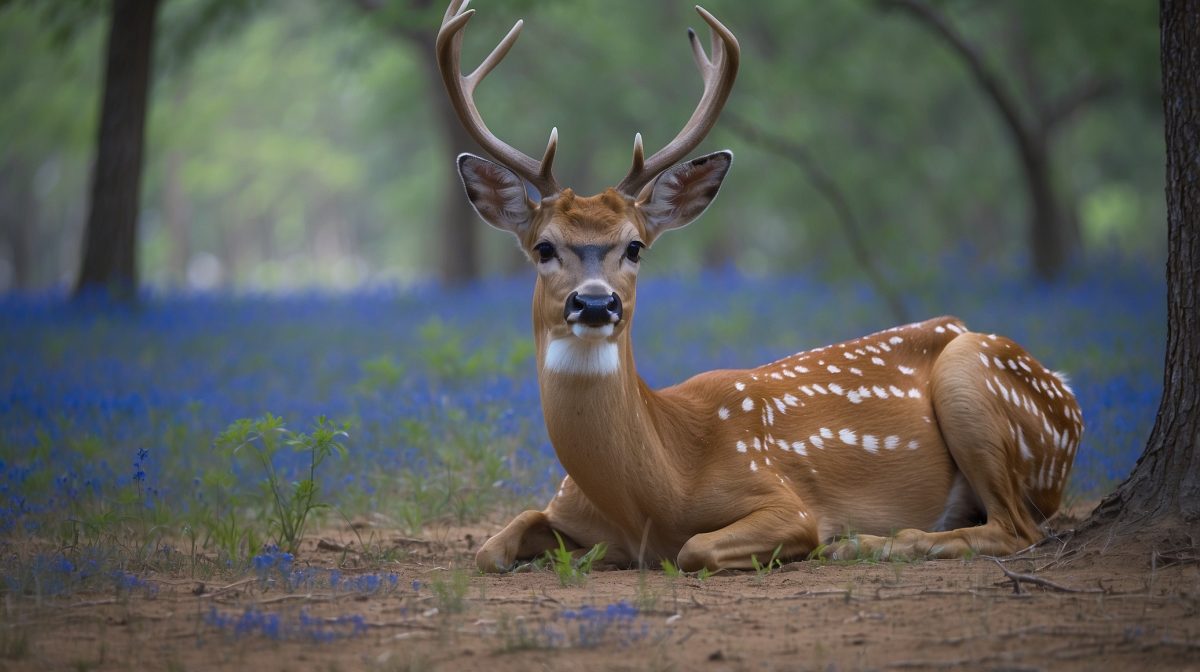The Axis Deer
Axis deer, they came to us all the way from India and Sri Lanka, making their Texas debut on a private ranch in the 1930s. Since then, they’ve been living it up in our neck of the woods, and I’ll tell ya, they sure stand out with their reddish coats and white spots, not to mention those long, three-pronged antlers they sport. Now, these ain’t your typical white-tailed deer that you might see around these parts; Axis deer are a whole different breed with a beauty that’s hard to match.
Comparing Axis to our native deer is like comparing brisket to a sirloin – both good, but each with its own flavor. Axis deer are bigger bodied, with males that can weigh a hefty 250 pounds. They don’t follow the same seasonal patterns as our local deer, and they’re known for being more vocal. It’s these differences that make them such a fascinating addition to the Texas wildlife family and a prized catch for any hunter worth their salt.
Behavior of Axis Deer
When it comes to socializin’, Axis deer like to stick together in groups, sometimes forming herds that can number in the hundreds. Within these herds, there’s a hierarchy, with dominant males struttin’ their stuff and keeping watch over the females and youngsters. It’s a sight to see, especially when you catch them during the early morning or late evening, grazing and moving as one big family.
Now, if you’ve ever been out in the Hill Country and heard a high-pitched call, you might’ve just heard the Axis deer chattin’ among themselves. They’re a chatty bunch, using different sounds to signal everything from alarm to courtship. And speakin’ of courtship, these deer don’t play by the same seasonal rules as other deer – no sir, they can breed year-round, which means you’re likely to see little fawns at any time of year. This non-stop breeding cycle is one reason why they’ve done so well out here in Texas.
Habitat Preferences in Texas Hill Country
Axis deer have a particular fondness for the kind of landscapes we got here in Texas Hill Country. They’re all about the dense brush and forested areas that offer them plenty of cover, but they don’t mind coming out to the open fields to graze, either. The reason they’ve taken to this place like a duck to water is simple: it’s got everything they need, from the shelter of the oak trees to the abundance of forbs and grasses that make up their diet.
These deer are survivors, adapting to the hot summers and mild winters without missing a beat. They’re not just surviving; they’re thriving, and that’s in part due to the land management practices we’ve got going on. Responsible conservation efforts ensure that the land provides for the Axis deer without tipping the balance of our local ecosystems. It’s a delicate dance between nature and nurture, and we’re proud to be part of it.
Axis Deer and Texas Ecosystems
Axis deer play a unique role in our Texas ecosystems. They’re part of the food chain, sure, providing sustenance for predators like coyotes and bobcats. But their grazing habits also have an impact on the vegetation, which can affect the other species that call this place home. It’s a complex web of interactions, and these deer are right in the middle of it.
Now, it’s natural to wonder if these non-native deer might be throwin’ a wrench in the works of our local habitats. But from what we’ve seen, they can coexist with our native plants and animals without causing too much of a ruckus. That said, we’ve gotta keep an eye on their numbers and make sure they don’t overrun the place, which is where responsible hunting and land management come into play.
The Hunter’s Guide to Axis Deer
If you’re lookin’ to hunt Axis deer, you gotta understand their seasonal patterns. Unlike native deer that have a set rutting season, Axis deer can be a bit unpredictable, which makes hunting them an exciting challenge. They’re most active during dawn and dusk, so that’s your best bet for catchin’ a glimpse of them. And when it comes to the Texas heat, you’ll find them seeking shade during the day, which can affect how and when you plan your hunt.
Tracking these deer takes a keen eye and an understanding of their behavior. Look for signs like hoof prints, rubbed trees, and bedding spots. And remember, these deer are smart – they’ll use the terrain to their advantage, sticking close to water sources and dense cover. So when you’re out there in the brush, take a page out of the Axis deer’s book and be patient, observant, and respectful of the land.
Conservation and the Future of Axis Deer in Texas
Hunting Axis deer isn’t just about the thrill of the chase; it’s also about conservation. We’ve got to balance the need for sport with the health of the population, ensuring that these beautiful creatures continue to grace our landscapes for generations to come. It’s a responsibility that we take seriously, and it’s one that benefits both the deer and the hunters.
Research and monitoring are key to understanding how Axis deer fit into the bigger picture of Texas wildlife. Scientists and wildlife managers work tirelessly to keep tabs on the population, studying everything from their breeding habits to their impact on the environment. And let’s not forget the role of resorts and private lands, like the JL Bar Ranch Resort, which provide controlled environments for hunting and observation, contributing to the sustainable management of Axis deer.
Conclusion
Well, folks, we’ve covered a lot of ground here, talkin’ about the Axis deer and their place in Texas Hill Country. These animals are more than just a hunting prize; they’re a testament to the diversity and resilience of our wildlife. Understanding their behavior and habitat is crucial, not just for those of us who hunt, but for anyone who appreciates the natural beauty of Texas.
As we wrap up, I hope y’all can see why these Axis deer hold a special place in my heart. There’s something truly magical about watching them move through the brush or hearing their calls echo through the valleys. Whether you’re a hunter, a nature lover, or just someone who appreciates the wild things in life, I reckon the Axis deer of Texas Hill Country are worth your admiration and respect.
FAQs
What makes Axis deer different from native Texas deer species?
Axis deer stand out with their spotted coats, larger size, and unique vocalizations. They also breed year-round, unlike native deer with set mating seasons.
How can I tell if I’m looking at an Axis deer or a native deer?
Look for the distinctive white spots on a reddish coat, long antlers on males, and listen for their high-pitched calls – that’s your Axis deer right there.
When is the best time to hunt Axis deer in Texas Hill Country?
Early mornings and late evenings are prime times, but since they breed year-round, you’ve got a good chance of finding them any time of year.
Are Axis deer a threat to the local Texas ecosystem?
While they have adapted well, it’s important to monitor their numbers to ensure they don’t disrupt the balance of our local ecosystems.
Can Axis deer be hunted year-round in Texas, and are there any restrictions?
Yes, they can be hunted year-round on private land, but always check local regulations and practice ethical hunting.


